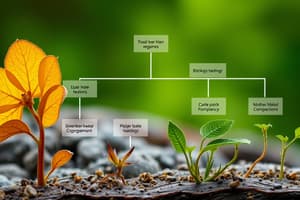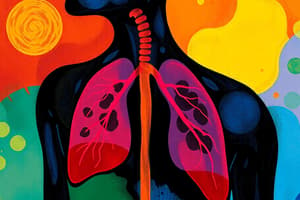Podcast
Questions and Answers
Which kingdom is primarily composed of unicellular organisms?
Which kingdom is primarily composed of unicellular organisms?
- Animalia
- Plantae
- Protista (correct)
- Fungi
What role do fungi primarily play in ecosystems?
What role do fungi primarily play in ecosystems?
- Symbiotic partners with animals
- Decomposers of dead organisms (correct)
- Producers of energy
- Consumers of plant matter
Which of the following levels of biological organization is directly made up of different populations?
Which of the following levels of biological organization is directly made up of different populations?
- Organism
- Ecosystem
- Community (correct)
- Habitat
Which of the following statements about ecosystems is correct?
Which of the following statements about ecosystems is correct?
What is a characteristic of populations?
What is a characteristic of populations?
Which kingdom is composed of multicellular photo synthesizers?
Which kingdom is composed of multicellular photo synthesizers?
Which of the following is NOT a level of biological organization?
Which of the following is NOT a level of biological organization?
What do all members of a biological community have in common?
What do all members of a biological community have in common?
Which characteristic defines an ecosystem?
Which characteristic defines an ecosystem?
What is the range of organisms included in the kingdom Protista?
What is the range of organisms included in the kingdom Protista?
Flashcards are hidden until you start studying
Study Notes
Biology Overview
- Biology: Study of living things; derived from Greek bios (life) and logos (knowledge). Known as Life Science.
Characteristics of Life
-
Organized Structure: Life displays levels of biological organization.
- Cell: Basic unit of life.
- Tissue: Group of similar cells performing a function.
- Organ: Composed of multiple tissues working together.
- Organ System: Collection of organs collaborating for a common purpose.
- Complex Organisms: Structures like trees and humans are systems of multiple organ systems.
-
Energy and Materials: Organisms need external sources of energy and materials to sustain life and maintain organization.
-
Reproduction: Living organisms reproduce through genes in DNA, which contains hereditary information for cellular structure and metabolism.
Responses and Adaptations
- Response to Stimuli: Organisms react to changes in their environment, often moving towards food sources.
- Homeostasis: Maintenance of a stable internal environment; body temperature in humans shows slight fluctuations.
- Growth and Development: Growth indicates an increase in size and cell number, while development encompasses changes from conception to death, including recovery from injuries.
- Adaptations: Modifications that enhance an organism's survival; exemplified by a hawk's hunting traits.
Evolution and Species
- Evolution: Process of change in species over time.
- Species Definition: Group capable of mating and producing fertile offspring.
Biological Classification
- Organisms classified hierarchically: species, genus, family, order, class, phylum, kingdom, domain.
- Domains: Three primary domains include:
- Archaea: Unicellular prokaryotes.
- Bacteria: Unicellular prokaryotes without membrane-bound nuclei.
- Eukaryota: Organisms with a nucleus containing genes.
The Four Kingdoms of Eukaryota
- Protista: Vary from unicellular to simple multicellular organisms.
- Fungi: Includes molds and mushrooms; decomposers of organic matter.
- Plantae: Multicellular organisms that perform photosynthesis.
- Animalia: Multicellular organisms that consume food.
Levels of Biological Organization
- Organism: Individual life form.
- Population: Group of the same species living in the same area at the same time.
- Biological Community: Interactions of different populations in a specific area.
- Ecosystem: Interplay between multiple populations and abiotic (non-living) environment factors.
Studying That Suits You
Use AI to generate personalized quizzes and flashcards to suit your learning preferences.




